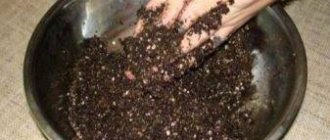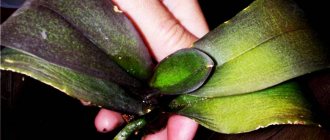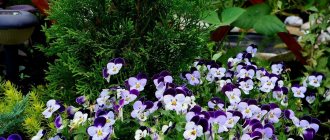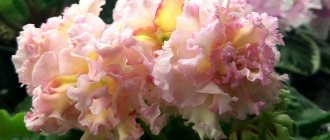What does violet Raisin look like?
The Raisin variety belongs to the Violet genus and the Violet family. There are more than 600 species of this plant in the world, but even against their background, Raisin can surprise.
Violet Raisin with variegated flowers
Violet Raisin or DS-Raisin has a very memorable appearance due to its unusual inflorescences.
The compact bush has a height of 30-40 centimeters. The leaf blades grow directly from the basal rosette and have a teardrop shape. Their surface is smooth, and the color is solid dark green without inclusions or light areas or veins.
Violet DS Raisin was developed by crossing varieties found at the end of the 19th century by a British baron who traveled to East Africa. Breeders made many different hybrids of these flowers in the mid-20th century, the most beautiful of which was the DS Raisin violet.
This is interesting! Among some plant lovers there is an opinion that in Latin violet is written as “violet”. In fact, this is not so - in the West they are called Saintpaulia (Latin: Saintpaulia).
What is sport among fantasy saintpaulias?
You can often hear the term “violet sport”, what does this mean? There is nothing complicated in this word; this is how they designate varieties that, over a long period of cultivation, have managed to lose the properties and characteristics of their ancestor variety. As a rule, such flowers can already be called a new subspecies of violets.
- Leaf sport
Leaf blades may undergo noticeable changes in shape and color. This is influenced by the conditions under which the bush is kept, the method of its propagation, the quality of fertilizing and the pH level of the soil.
- Sport of flowers
Violet sport suffers noticeable changes in the characteristics of its flowers. Due to genetic mutations and the effects of certain external factors, the color and shape of the inflorescences can completely change. Raisin's ancestors had a solid lilac color, and the current plant has left this external resemblance to a small extent.
Features of caring for violet DS Raisin at home
Violet Fairy - description and characteristics of the variety
Violets cannot be called unpretentious flowers, as there are several nuances in their care that need to be paid special attention to.
- Temperature
The most comfortable temperature for the heat-loving violet is +23 degrees. A decrease or strong changes in its maintenance regime will lead to negative consequences for the plant.
- Lighting
The bush should be grown in an open place, but direct sunlight often burns the leaf blades of the flower, so the pot should be placed not on the southern sides of the house, but on the western or eastern side.
The plant needs to be watered regularly
- Watering
The soil in the pot should always be moist, but loose. It is recommended to water the plant 2-3 times a week, and mulching can be done to retain moisture.
Important! After watering, it is recommended to loosen the soil 2-3 centimeters deep.
- Spraying
Spraying is very necessary for Zest, especially during dry periods. In addition, this procedure removes dust and dirt from the leaf plates of the bush.
- Humidity
Air humidity is of great importance for the normal growth of the bush. The most optimal indicator is 50%.
To increase humidity, water is sprayed near the violet bush, and the leaf blades are carefully wiped with a damp cloth.
- Priming
The soil in the pot should be loose and light. To ensure that the flower does not lag behind in development, fertilizers must be regularly added to the soil.
- Feeding
For feeding, it is better to choose ready-made complex mineral preparations. They should contain high levels of phosphorus and potassium.
Fertilizing violets should be carried out only in spring and summer; in autumn and winter they are contraindicated due to the excess load on the bush.
Rules of care
All varieties of violets are very heat-loving. They need to be placed in a place that gets a lot of light.
However, it is necessary to do this taking into account that the flower itself is not exposed to direct sunlight, since in this case it can get burned. The optimal room temperature is 22-23 degrees.
It is worth watering the plants as the soil dries, with clean water. Tap water must sit in an open container for at least a day so that all the chlorine evaporates. When watering, water should not get on the flower itself.
If there is a lack of light and water, the plant may become deformed, and the shape and location of the flower itself will change.
Fertilizers should be bought in special stores; if you want to achieve abundant flowering, they must contain phosphorus. The flower should be fertilized in spring and summer; under no circumstances should fertilizer be added in winter and autumn.
In this case, an additional load is placed on the plant, instead of the required rest.
Attention! It should be remembered that although violets love water and humidified air, you need to know when to water them. If the soil is allowed to become waterlogged, the plant will die.
Selecting a location
Although the violet is an unpretentious plant, in order for it to please with a healthy appearance and flowering, it must be located in the right place.
Since this flower loves sunlight very much, it should be placed on a windowsill in the western or eastern part of the house.
At the same time, it must be placed in such a way as to protect it from drafts.
If it is impossible to provide sufficient lighting, you can use a special lamp for 12-14 hours. Those. organize “additional lighting”.
Choosing a pot
When choosing a pot, you need to consider why you want to replant. If the plant has become crowded and the roots have filled the entire volume, then you need to choose a slightly larger container. If you just need to update the soil, then a large pot is not required.
With a large amount of free space, the root system begins to actively develop, and the plant stops blooming.
If you want to achieve flowering, you should focus on a pot with a diameter of about 5-7 cm. When choosing a plastic pot, you should check whether it has drainage holes that will allow the roots to breathe and drain excess water
The plastic itself does not allow air into the pot
When choosing a plastic pot, it is worth checking whether it has drainage holes that will allow the roots to breathe and drain excess water. The plastic itself does not allow air into the pot.
Attention! When transplanting violets from one pot to another, it is worth considering that the new pot should be slightly larger than the previous one
Soil selection
When choosing soil, you need to pay attention to its quality. It should contain all useful microelements and be quite loose
When replanting, you should not use soil from an old pot, as most likely it is completely depleted and will not be able to provide the flower with nutrition.
You can use homemade mixtures as soil for the flower.
But the easiest way is to purchase soil in a specialized store.
When and how does it bloom
Violet Magenta - description and characteristics of the variety
The blossoming of Raisins is a beautiful and memorable event thanks to the colors of the small buds.
The flowers have one type of color and shape for the entire variety. They are painted in a delicate purple hue and have small white specks on each petal. But some of them only have these dots on the edges.
Violet blossom Raisin
One rosette can contain from 5 to 10 flowers, which consist of one large wavy petal. Short yellow stamens are clearly visible in the middle.
For reference! Violet has two noticeable waves of flowering. The first begins in early April and continues until May, the second will follow immediately - from May to June.
Changes in care during the flowering period
During flowering, the frequency of fertilizing begins to be reduced, and nitrogen-containing preparations are stopped altogether.
Also during this period, the bush should be slightly moved away from the window so that the bright sun does not harm the buds.
How to prune a bush correctly
Violet, unlike some other plants, does not require systematic removal of petals.
However, to maintain a certain shape, it is necessary to maintain uniform proportions: the bush must consist of three uniform rows of leaves.
Violet “Raisin” is suitable even for those people who do not have a lot of time for household chores. This variety is very unpretentious and easy to care for. Violet can harmoniously complement any interior and “revive” it.
If the violet that you grew from a leaf often gets sick and does not bloom, we advise you to read the materials at the links.
In order for the violet to be even and symmetrical, it is necessary to periodically shape it. It must be remembered that the rosette of the plant should consist of 3 rows of leaves. If there is a bunch of leaves in the center, the flower will not form correctly, but will begin to grow in all directions.
First of all, you need to get rid of yellowed and diseased foliage. In order to properly separate it from the trunk, you need to grab the leaf with your thumb and forefinger and press the base with your nail. After this, it is enough to separate the unwanted element of vegetation using twisting movements.
If, after trimming the bush, the violet trunk looks bare, you need to bury it a little into the ground.
How Saintpaulia DS Raisin propagates
Picture 4 Planting a seedling in the ground
Violet SM Amadeus pink - description and characteristics of the variety
Saintpaulia is propagated by rooting leaves. The description of the procedure is as follows:
- cut off a leaf from an adult plant at the root;
- put its end into the water;
- When the leaf has roots, you need to transplant it into a container with substrate.
Attention! It is best to cut medium-sized leaves, not the oldest ones, but not the youngest ones either.
Reproduction
Theoretically, Saintpaulia Magenta can be propagated by seeds and the vegetative method. In practice, only the second method is used in home gardening. If propagated vegetatively, then two options are applicable: by dividing the bush and by leaf.
Dividing the bush is used when the plant has flowered.
The division technology is as follows:
- The bush is carefully dumped out of the container, and the baby is separated with a sharp knife.
- The delenka is planted in a small pot, up to 6 cm in diameter, and covered with something, forming something like a greenhouse.
- Ventilate and water in small portions daily.
- The mother bush is freed from dry parts and transplanted into a new pot.
The requirements for it are:
- the sheet should not be old and not from the lowest row;
- absence of signs of disease on the material (suspicious spots, burn marks);
- the cutting must be healthy, and the plate must be elastic and dense.
Further sequence of actions:
- The cuttings are cut at an acute angle of 45°.
- Root in boiled water, adding activated carbon, which will prevent rotting.
- After roots 1–1.5 cm long appear, the leaf cuttings are transplanted into the ground.
- Bury the cutting into the soil no more than 1 cm, and if necessary, provide a support for the leaf.
- Further care is the same as for an adult plant.
Did you know? South Germanic tribes celebrated the first day of spring when the first violet was found. And the find promised a profitable marriage and prosperity in family life to the lucky one.
Transplantation after purchase and during reproduction
To replant, you need a high-quality and nutritious soil mixture, which you can purchase in specialized stores or make yourself. You need to take loose turf soil and mix it with river sand and humus.
Before pouring the substrate into the pot, you need to cover its bottom with drainage material; expanded clay chips are ideal. Afterwards, the container is filled one third with soil mixture and the Saintpaulia is replanted.
It is not recommended to replant violets immediately after purchase. It is advisable to keep it separate from other plants for 7-10 days, observing quarantine.
Possible problems in growing
All Saintpaulia problems arise from improper care. Excessive watering and dry air are a good environment for diseases and pests to arise.
Problems with leaves
A distinctive feature of the Raisin variety is not only its buds, but also its smooth and shiny leaves. However, they often begin to lose their natural beauty and the reasons for this phenomenon may be:
- lack of watering, which causes the leaves to fade and begin to dry out;
- lack of minerals in the soil causes leaves to curl and brown spots to appear;
- hypothermia of the bush - wilting of leaves, darkening of them in the axils.
Pests
Among the pests that affect violets are:
- thrips - suck juices from fleshy leaves;
- mealybugs - provoke the appearance of powdery mildew;
- mites - not visible to the naked eye, the first sign of appearance is a thickened root rosette;
- nematodes are whitish worms that infect the roots of a flower.
At the first symptoms, you need to treat the violet with insecticides.
Diseases
The most common violet diseases:
- powdery mildew - characterized by the appearance of a white coating on the leaves;
- rust - the formation of brown bulges on the foliage;
- bacteriosis - death of the lower leaf blades;
- root rot - rotting of the root zones of a bush.
For treatment, you need to completely cut off the affected parts, and treat the rest of the shoots with fungicides.
Powdery mildew on violet
In case of root rot, it is recommended to replant, completely changing the soil.
Signs of improper care
If the bush begins to fade and stops in its development, this may mean that mistakes were made in its care. Violet often reacts to unfavorable external factors by lack of flowering, yellowing and curling of the foliage.
Important! The causes of problems can be not only insufficient care, but also its excessiveness. Abundant watering and frequent feeding negatively affect the health of the flower.
Violet Raisin is a delicate flower that requires special care. It can sometimes be difficult for beginners to cope with the capricious nature of the plant, but by coping with this problem, you can achieve bright and unusual flowering of the bush.











